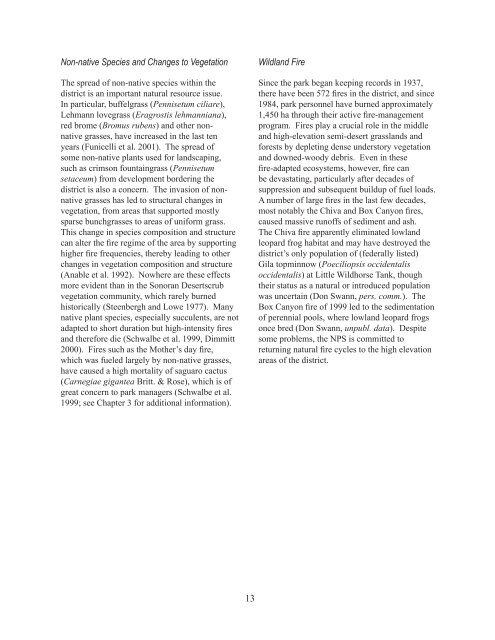Vascular Plant and Vertebrate Inventory of Saguaro ... - USGS
Vascular Plant and Vertebrate Inventory of Saguaro ... - USGS
Vascular Plant and Vertebrate Inventory of Saguaro ... - USGS
You also want an ePaper? Increase the reach of your titles
YUMPU automatically turns print PDFs into web optimized ePapers that Google loves.
Non-native Species <strong>and</strong> Changes to Vegetation<br />
The spread <strong>of</strong> non-native species within the<br />
district is an important natural resource issue.<br />
In particular, buffelgrass (Pennisetum ciliare),<br />
Lehmann lovegrass (Eragrostis lehmanniana),<br />
red brome (Bromus rubens) <strong>and</strong> other nonnative<br />
grasses, have increased in the last ten<br />
years (Funicelli et al. 2001). The spread <strong>of</strong><br />
some non-native plants used for l<strong>and</strong>scaping,<br />
such as crimson fountaingrass (Pennisetum<br />
setaceum) from development bordering the<br />
district is also a concern. The invasion <strong>of</strong> nonnative<br />
grasses has led to structural changes in<br />
vegetation, from areas that supported mostly<br />
sparse bunchgrasses to areas <strong>of</strong> uniform grass.<br />
This change in species composition <strong>and</strong> structure<br />
can alter the fire regime <strong>of</strong> the area by supporting<br />
higher fire frequencies, thereby leading to other<br />
changes in vegetation composition <strong>and</strong> structure<br />
(Anable et al. 1992). Nowhere are these effects<br />
more evident than in the Sonoran Desertscrub<br />
vegetation community, which rarely burned<br />
historically (Steenbergh <strong>and</strong> Lowe 19 ). Many<br />
native plant species, especially succulents, are not<br />
adapted to short duration but high-intensity fires<br />
<strong>and</strong> therefore die (Schwalbe et al. 1999, Dimmitt<br />
2000). Fires such as the Mother’s day fire,<br />
which was fueled largely by non-native grasses,<br />
have caused a high mortality <strong>of</strong> saguaro cactus<br />
(Carnegiae gigantea Britt. & Rose), which is <strong>of</strong><br />
great concern to park managers (Schwalbe et al.<br />
1999; see Chapter 3 for additional information).<br />
13<br />
Wildl<strong>and</strong> Fire<br />
Since the park began keeping records in 193 ,<br />
there have been 572 fires in the district, <strong>and</strong> since<br />
1984, park personnel have burned approximately<br />
1,450 ha through their active fire-management<br />
program. Fires play a crucial role in the middle<br />
<strong>and</strong> high-elevation semi-desert grassl<strong>and</strong>s <strong>and</strong><br />
forests by depleting dense understory vegetation<br />
<strong>and</strong> downed-woody debris. Even in these<br />
fire-adapted ecosystems, however, fire can<br />
be devastating, particularly after decades <strong>of</strong><br />
suppression <strong>and</strong> subsequent buildup <strong>of</strong> fuel loads.<br />
A number <strong>of</strong> large fires in the last few decades,<br />
most notably the Chiva <strong>and</strong> Box Canyon fires,<br />
caused massive run<strong>of</strong>fs <strong>of</strong> sediment <strong>and</strong> ash.<br />
The Chiva fire apparently eliminated lowl<strong>and</strong><br />
leopard frog habitat <strong>and</strong> may have destroyed the<br />
district’s only population <strong>of</strong> (federally listed)<br />
Gila topminnow (Poeciliopsis occidentalis<br />
occidentalis) at Little Wildhorse Tank, though<br />
their status as a natural or introduced population<br />
was uncertain (Don Swann, pers. comm.). The<br />
Box Canyon fire <strong>of</strong> 1999 led to the sedimentation<br />
<strong>of</strong> perennial pools, where lowl<strong>and</strong> leopard frogs<br />
once bred (Don Swann, unpubl. data). Despite<br />
some problems, the NPS is committed to<br />
returning natural fire cycles to the high elevation<br />
areas <strong>of</strong> the district.

















